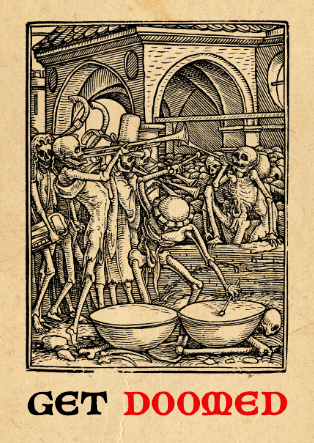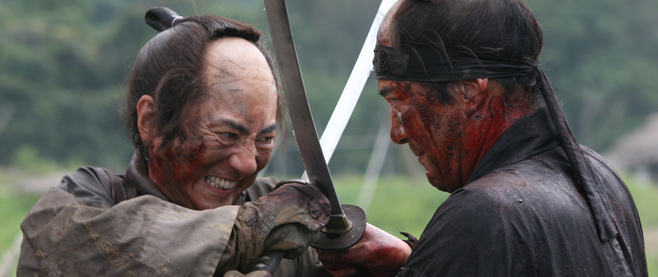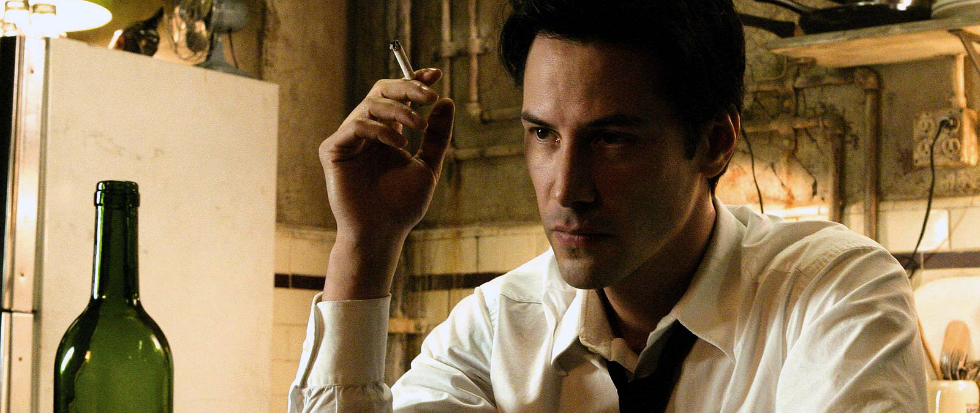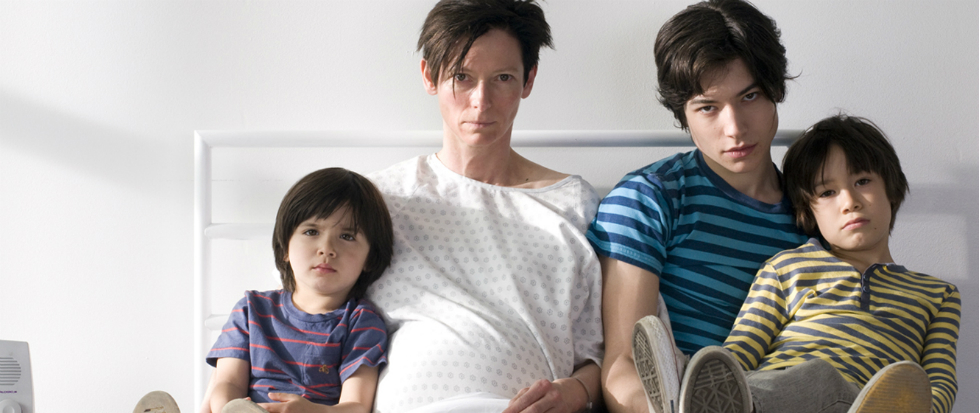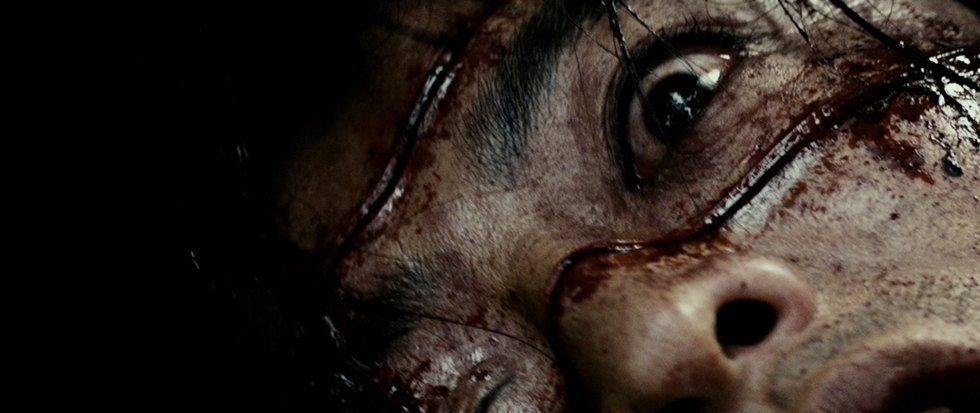
What Happens Now Will Drive You Mad
When the filmography of one director includes more than a hundred movies and counting (Blade of the Immortal is #100), it’s a daunting prospect to look back across that career and act as if you understand it. Of Takashi Miike’s hundred-plus movies, I have seen perhaps a dozen, so rendering a verdict, or even a summation, of the man and his oeuvre seems arrogant at best.
And yet, of course I feel like I do have at least some mental picture of what I expect when I sit down to watch a Takashi Miike film; those dozen-or-so movies sticking in my mind with enough power to cement at least some parts of the reputation that precedes the prolific director: irreverent, unpredictable, at times absurd, frequently violent, often brilliant.
Perhaps best known in the United States either for his ultraviolent 2001 yakuza film Ichi the Killer or the almost unbearably intense and grotesque Audition—which was actually my ice-cold introduction to Miike’s work more than a decade ago—my favorites by far have been his recent forays into making old-fashioned samurai epics, with 13 Assassins taking a spot in my personal pantheon as a genuine classic, full stop.
Which is all an extremely long-winded way of saying that Blade of the Immortal seems like a natural fit for Miike’s hundredth film, if such a thing can be said to exist at all. Blade of the Immortal feels like a bridge of sorts between the more absurd and ultraviolent work for which he is better known and his more stately (if still sometimes absurd and often violent) samurai pictures, not to mention an obvious outlet for some of his more outlandish sensibilities.
As such, Blade of the Immortal also feels like a solid entry point for viewers new to Miike’s oeuvre. Which, honestly, making your hundredth film something that seems in keeping with your recent work, reminiscent of your early work and perhaps more-than-usually approachable for those who’re coming to your filmography cold feels like something of an accomplishment in itself.
The film opens in black-and-white, with a spray of blood across the screen followed, in short order, by a gag in which a mentally unhinged character mistakes a horse turd for a rice ball. And that’s Blade of the Immortal summarized for you pretty well, before the titles even really roll.

After a suitably epic opening slaughter, the black-and-white gives way to color with the introduction of the film’s central conceit. For those who are unfamiliar with the manga upon which the movie is based, Blade of the Immortal follows the exploits of Manji, a masterless samurai who has been infected with “sacred blood worms,” rendering him effectively immortal. The worms rapidly repair any damage that our hero sustains, even reattaching severed limbs. Think Wolverine, but with much more horrific injuries. As you can probably imagine, Blade of the Immortal is an incredibly bloody film, even in the annals of samurai movies, which have a well-earned reputation for pouring on the red stuff.
I watched Blade of the Immortal on a screener copy while recovering from emergency surgery. The “healing factor” angle is always an enticing one, no matter how hard storytellers try to focus on the intense agony that comes with being able to endure so much damage—something that Blade of the Immortal actually sells better than most—and never has that been more true than when I was in the midst of a long and slow and painful recovery from what was, compared to the bodily trauma and dismemberment which Manji sustains (and inflicts) throughout the film, a relatively minor injury.
I’ve never read the manga upon which the movie is based, but it was pretty popular back when I was still more actively into comics than I am today, and I remember absorbing some information about it via osmosis. One key attribute that seems to be missing from the film is the idea that Manji can regain his mortality—and therefore finally die—by killing “one thousand evil men.” Perhaps this was abandoned due to the limitations of the film’s running time, or because the movie is every bit as much the story of Rin, the young girl who “adopts” Manji as her bodyguard, as it is about the deathless samurai himself, but it could just as easily have been jettisoned because the film goes out of its way to avoid letting the labels of “good” or “evil” rest too easily on anyone’s shoulders.
A running theme throughout Blade of the Immortal is the question of what, if anything, differentiates the good guys from the bad ones. Having the villain taunt the hero with comparisons while the hero shouts “I’m nothing like you!” may be a cliché by now, but here the fundamental accuracy of the assessment—coupled with the fact that the “hero” in question is literally still a child—transforms the whole thing into something that feels much less worn-out.
Aside from the bit about the “thousand evil men,” a cursory glance at the Wikipedia entry for the manga makes it look as if the film hews surprisingly close to the plot of the entire series. Which means that, for most of its two-hour-and-twenty-minute runtime, it is made up of a string of episodic encounters as Manji goes up against one weirdo or another in increasingly violent clashes. These various adversaries all have the larger-than-life quality that we associate with anime characters, including one early nemesis who keeps seemingly-living human heads impaled on his shoulders.
In fact, one of the things that Blade of the Immortal does best is to make everything feel like part of something bigger than itself. When I use the words “comic book” to describe the feel of a movie, I am sometimes referring to a certain pulp quality to the action, but more likely I’m trying to convey a sense of that feeling of a larger universe that (specifically superhero) comic books tend to occupy. Blade of the Immortal is comic book-y in exactly that sense (and the pulp aesthetic one, too), feeling as if, at any moment, an entire other movie could pass right through the middle of this one without even leaving a hole.
Before I sat down to watch Blade of the Immortal, one of the only reviews I had read of it—from when it played at Fantastic Fest earlier this year—had complained about the episodic nature of the film, saying that, after a while, it became something of a slog to watch Manji go up against foe after foe in bloody combat. Interestingly enough, I was spared this experience somewhat because one of the unexpected side effects of the drugs that I was on following my surgery was that it was all-but impossible for me to watch more than about twenty to forty minutes of the movie at a time, so I experienced it broken up into a handful of smaller chunks. In this form, the episodic nature of the movie felt completely natural—reminiscent of reading a manga series, in fact. Even if Manji’s fights had ultimately taken on the nature of a slog, though, I can’t help but feel like that would have seemed intentional, serving as a pretty succinct summary of Manji’s existence and why he might wish to escape it.

I also saw someone claim that Manji wasn’t actually a very good samurai because he got cut up so much, which seemed more than a little off the mark to me. Leaving aside the fact that, for the majority of the film’s running time, Manji is going up against characters who have been established as among the best fighters in the world—so good, in fact, that their nefarious agenda includes traveling around and killing all the existing masters—by the time the film’s action takes place, he has also had fifty years to establish a fighting style that takes advantage of the fact that he can’t die while his opponents can. (I’m told this is a subject that the manga gets into more explicitly.) That probably leads to getting cut up a lot.
And make no mistake, Manji does get cut up a lot, even while he also cuts up a lot of other people. While there is never anything in Blade of the Immortal quite as intense as the intentionally exhausting 45-minute final battle of 13 Assassins, the ultimate body count here may actually be even higher, with the film’s final duel taking place in the midst of an almost literal sea of corpses.
Yet, Blade of the Immortal feels considerably lighter than 13 Assassins. In my limited experience, even Takashi Miike’s most tragic movies are often a little bit funny, and his funniest movies usually have something of tragedy in them. That’s certainly true here. While proceedings get fairly heavy by the end—and while sexual violence, or the threat of same, rears its ugly head a few times before the film is out—nothing in Blade of the Immortal ever sinks to the depths of depravity that its subject matter might suggest, no matter how much blood is spilled in bright red rivers across the screen.
Perhaps because of this very lightness, Blade of the Immortal isn’t 13 Assassins or even Miike’s 2011 remake of Hara-Kiri, and it doesn’t try to be, and it doesn’t need to be. Instead, it takes the craft and beauty of those films, and weaves them into a broad and boisterous gonzo comic book tapestry of violence, vengeance, and over-the-top… well, pretty much everything. When there’s this much energy in Miike’s one-hundredth movie, it’s not too difficult—or at all unpleasant—to imagine that he’s still got one hundred more in him.
